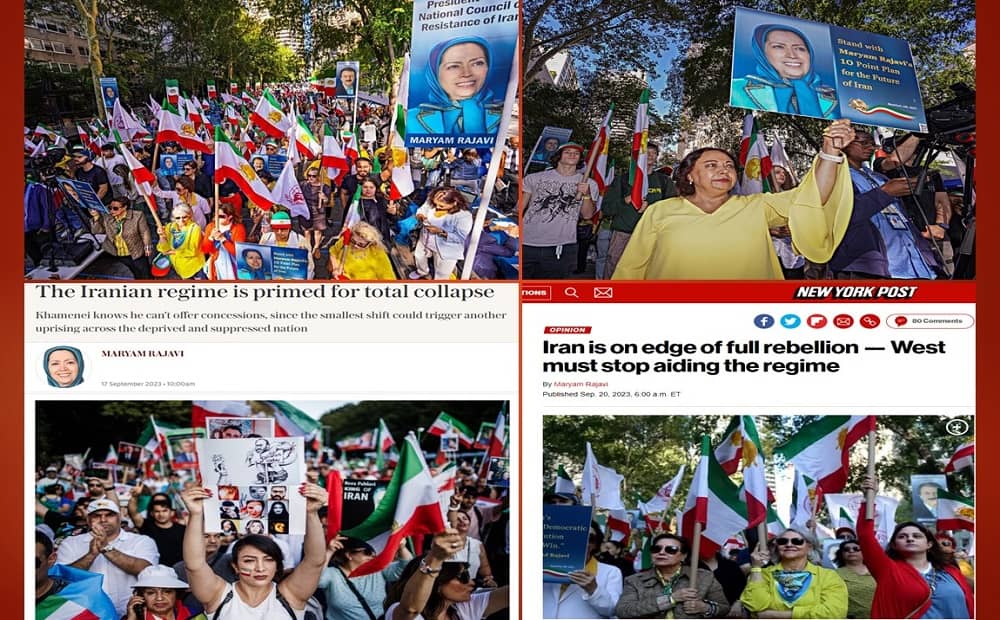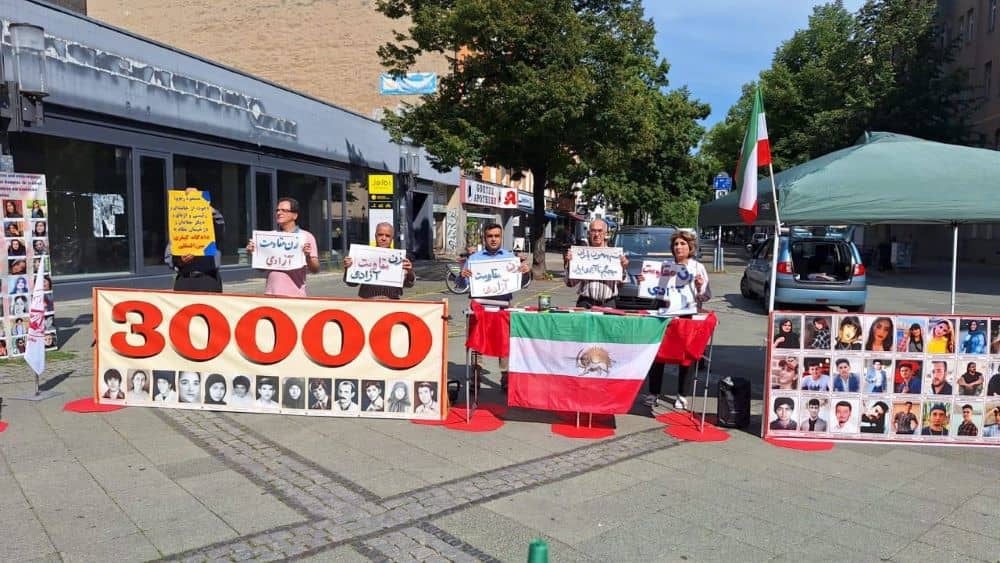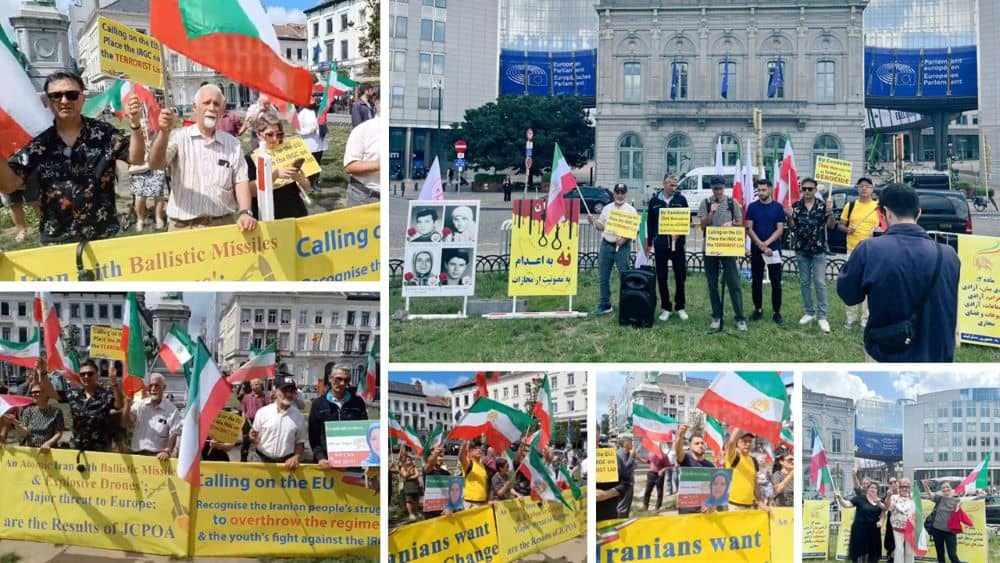
Mrs. Maryam Rajavi, the President-elect of the National Council of Resistance of Iran (NCRI), wrote an Op-ed in The British Telegraph on September 17 and another in The New York Post on September 20, examining the current situation in Iran under the religious dictatorship.
Mrs. Rajavi described the revolutionary state of Iranian society and the organized resistance against the mullahs’ regime.
In The Telegraph, Maryam Rajavi presented a comprehensive review of the shaky situation of the Iranian regime. By examining the multifaceted dynamics of Iranian society, her analysis sheds light on the growing dissatisfaction caused by economic instability, high unemployment rates, and systematic discrimination. Among these challenges, Mrs. Rajavi emphasizes the resilience of the Iranian people, who are determined to seek freedom and criticize the regime that resorts to repression to maintain power. This article also calls for a revision of international policies, encouraging a departure from appeasement and firmly acknowledging the fundamental right of the Iranian people to resist oppression.
Mrs. Rajavi, in an article published on September 20 in The New York Post, discussed the critical situation in Iran. Referring to the speech of the President of the Iranian regime at the United Nations General Assembly on September 19, she asked the international community to reconsider its approach toward the regime that is on the verge of collapse.
Mrs. Rajavi highlighted the profound changes in Iran’s political landscape in the past year, marked by widespread protests and increased resistance. She emphasized the need to adopt a decisive Western policy that refrains from helping the oppressive regime and stands by the aspirations of the Iranian people for freedom and democracy.
Below, you can read the republishing of these two articles by Mrs. Rajavi in the Telegraph and the New York Post:
Mrs. Rajavi in Telegraph: The Iranian regime is primed for total collapse

Khamenei knows he can’t offer concessions, since the smallest shift could trigger another uprising across the deprived and suppressed nation
Almost exactly a year ago, a remarkable nationwide uprising unfolded in Iran. It witnessed people from all walks of life chanting “death to [regime supreme leader Ali] Khamenei” and “down with the oppressor”. These powerful words reflected the popular rejection of the clerical regime. In mere days, the uprising became a firestorm of dissent that encompassed every province and shook the ruling theocracy to its core.
In response, the regime embarked on a campaign to ruthlessly suppress the revolt. The past year has been unmistakably characterised by the people’s uprising on the one hand, and the regime’s relentless crackdown on the other. However, when we contemplate the future of Iran, a fundamental question arises: which one of these forces will ultimately shape the nation’s destiny?
The mullahs want to convey the impression that the balance of power has reverted to its pre-uprising status. But the daily realities experienced by the people paint a starkly contrasting narrative. A bankrupt economy, unbridled inflation, chronic unemployment, and institutionalised discrimination are contributing to a situation in which Iranian society is primed to erupt again.
The events of September 2022 revealed widespread discontent transcending class, region, generation and gender. It was led by women. The middle and lower classes came to the streets in major urban centres and smaller towns. And in spite of the regime’s four-decade endeavor to exert control over universities, students played a leading role in the uprising, often receiving resolute support from fellow citizens. There was also unprecedented participation from high school students. This epitomised the people’s fervent longing to oust the theocracy, which, for over four decades, has clung to power through brutal repression. Despite its brutality, the regime has failed to eliminate the organised resistance.
Western analysts, taken aback by the profound societal discontent, might have been less surprised had they been attuned to recent developments in Iranian society. Several nationwide uprisings have unfolded since December 2017, steadily increasing in frequency, scale and social inclusiveness, while the demands of participants have grown progressively radical.
All of this is compounded by the fact that the regime is woefully incapable of enacting major economic, political or social changes. It knows that any substantial change would risk spiralling out of control, intensifying the populace’s desire for self-governance and liberty, and ultimately hastening its own disintegration. Consequently, the regime can only rely on short-term, constrained measures to stifle dissent or temporarily placate the public. It has no long-term strategy to avert enduring conflict.
Khamenei is acutely aware that a larger uprising looms on the horizon. Yet his response remains confined to consolidating power within loyalist ranks, poised to enforce future suppressive measures. This only serves to bolster the people’s calls for a comprehensive regime change, escalating social tensions and setting the stage for a more devastating revolt.
The Iranian people are resolute in their quest for freedom. The West must now recalibrate its policies consistent with this reality in mind, and abandon the politics of appeasement. It should refrain from offering concessions to the regime, designate the Islamic Revolutionary Guard Corps as a terrorist organisation, and acknowledge the Iranian people’s inalienable right to resist against tyranny.
Mrs. Maryam Rajavi in New York Post: Iran is on edge of full rebellion — West must stop aiding the regime

With the Iranian regime’s president in New York, speaking to the United Nations just days after the anniversary of an uprising sparked by a brutal regime murder, it is essential the international community reflect on the far-reaching implications of this critical chapter in my nation’s history.
Over the past year, Iran’s political terrain has undergone a profound transformation. The regime is gripped by severe panic over impending protests, while the organized opposition continues to garner momentum. The world needs to recalibrate its approach toward this volatile regime — instead of continuing to appease and assist the murderers of the Iranian people.
The tragic death of Mahsa Amini, a 22-year-old victim of the regime’s “morality police,” triggered the September 2022. The embers of anger swiftly transformed into a sweeping blaze of protest against the entire theocracy that engulfed more than 220 cities, spanning all 31 provinces.
The world bore witness to the eruption of the Iranian people’s deep-seated yearnings for freedom, with women emerging as the uprising’s undaunted leaders. The unequivocal rejection of both monarchy and theocracy reverberated across the protests with the resounding cry, “Down with the oppressor, be it the shah or the supreme leader.”
The leading opposition movement, Mujahedin-e Khalq, has published the identities of at least 750 protesters the regime has killed. The demonstrators’ determination and courage were the culmination of a tireless battle, spanning the last four decades, against a regime defined by its brutality and oppression — a battle in which women have consistently led the way.
The reverberations of this uprising have intensified internal schisms at the highest levels and stoked a palpable fear of the future, along with a hemorrhaging of the regime’s ranks. The resurgence of mass protests, which by all logic would be more potent and powerful, is Tehran’s most dreaded nightmare.
Supreme Leader Ali Khamenei orchestrated Ebrahim Raisi’s ascent to the presidency with the aim of forging a more unified regime to forestall a recurrence of mass protests in 2018 and 2019. The 2022 uprising shattered even this semblance of regime cohesion, prompting a reevaluation of its strategy.
A recent so-called “purification wave,” spearheaded by Raisi, has seen the expulsion of dozens of university professors. It’s further evidence of the regime’s profound anxieties, notably regarding universities, which have historically served as bastions of spirited resistance against dictators. Now the regime has embarked on yet another sweeping purge.
This internal cleansing has even reached the doorstep of the Islamic Revolutionary Guard Corps Brig. Gen. Mohammad Baqer Qalibaf, parliamentary speaker and a former close confidant of Khamenei himself.
The waves of popular discontent are irrefutable evidence of the regime’s failure to fortify its internal cohesion and of its inexorable incapacity to forestall the recurring emergence of uprisings. So Khamenei has intensified repression.
There have been more than 500 executions since January 2023, according to international human-rights organizations. While these tactics may ratchet up intimidation in the immediate term, they will ultimately inflame dissent over the long haul.
Resistance Units inside Iran are the driving force for organizing and galvanizing an impassioned population. At least 3,600 members of these units have disappeared or been apprehended or killed. Nevertheless, Resistance Units continue to proliferate across Iran.
These brave youth operate covertly, enduring the constant specter of imprisonment, torture, and even death, cementing their role as the very backbone of the Iranian protest movement.
The Iranian people’s yearning extends far beyond cosmetic alterations to dress codes. Their ultimate goal is nothing less than toppling the oppressive regime and establishing a genuine democratic republic, casting off the shackles of both the shah’s dictatorship and the mullahs’ theocratic rule.
Democratic change in Iran has ceased to be a matter of conjecture; it has evolved into an inescapable reality. The unyielding resolve of the people, coupled with the growing unrest within the regime, renders the status quo untenable. A decisive and steadfast Western policy toward the Iranian regime can no longer be a mere exercise in prudence; it has become an imperative.
Tehran’s theocracy is at its weakest. It’s never been more in need of appeasement and diplomatic maneuvering — which, unfortunately, it’s getting. Unfreezing billions of dollars of Iranian people’s money and handing it over to the regime is a gift to Khamenei and his Revolutionary Guards for suppression, war, and terrorism.
The international community bears a moral obligation to stand with the Iranian people, who have made monumental sacrifices in their unrelenting quest for freedom. We don’t ask for help overthrowing the regime. We simply ask Western governments to stop providing these murderers aid. Then we can build a peaceful future based on the ideals of a secular, democratic, and non-nuclear republic.





